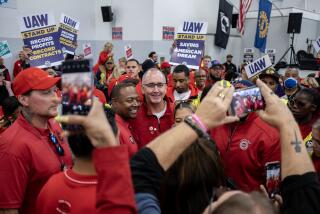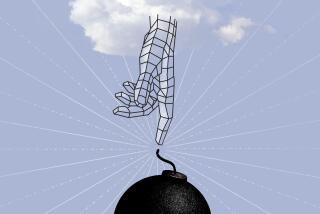BOOK REVIEW BUSINESS : A Lively Ride Into Future of Auto Making : COLLISION: GM, Toyota, Volkswagen, and the Race to Own the 21st Century <i> by Maryann Keller</i> , Doubleday/Currency, $25, 287 pages
- Share via
The collision to which Maryann Keller refers in the title of this book is not, she says, the one that might take place between the three car companies of the subtitle.
*
It is their collision with the future, a future that Keller, an automobile industry financial analyst, believes will be quite different from, and more challenging than, the past.
Keller is wise enough not to make specific predictions (aside from saying that she expects GM, VW and Toyota to be the global Big Three), but at the end of “Collision” she does put forward one remarkable judgment: that the best car company in the world right now is General Motors, because it is the one that has “most recently overcome great problems.”
That may or may not be true--Keller’s contention is less an argument than an aside--but “Collision” certainly details the problems that have haunted GM for years.
Keller places most of the blame on the doorstep of former GM Chairman Roger Smith, toward whom she shows no mercy. Although he green-lighted both the ground-breaking Saturn division and the Toyota-managed NUMMI plant in Northern California, Keller holds Smith (and his hand-picked successor, Robert Stempel) almost exclusively responsible for GM’s modern woes.
Under Smith, she writes, GM “no longer understood how it had to adapt in order to solve the problems many recognized,” its chief indulging in finger-pointing and denial to disguise the company’s ineffectiveness. Smith comes off as more interested in his personal financial health than that of his company.
Ferdinand Piech of Volkswagen fares better but only marginally so, because he is, well, German. Keller, not a tactful writer, considers that entire country arrogant.
The basic problem with VW, according to Keller, is systemic: The company has traditionally placed most of its eggs in one basket--first with the Beetle, then with the Golf/Rabbit--and so while reasonably good at building and selling cars, it has been sluggish in developing them in response to consumer tastes.
Moreover, being partially owned by the government of Lower Saxony and by strong, protective labor unions, VW has had difficulty changing with the times. Keller, quoting a 1990 MIT study, makes VW sound like Detroit circa 1975. The once-touted Halle 54, a highly automated, 11-year-old VW factory the size of Monaco, is described as “expending more effort to fix the problems it had just created than a Japanese plant required to make a nearly perfect car the first time.”
Although Japanese cars now represent the yardstick against which other automobiles are compared, Keller sees clouds before the Rising Sun as well.
A major problem facing Japan’s car companies, she argues, is that they are culturally homogenous and unused to international cooperation--particularly Toyota, a provincial, insular company even by Japanese standards. (Residents of Toyota City, the factory town two hours from Tokyo and once known as Koromo, are derisively referred to as “koromopolitan.”)
It’s unclear, though, why Toyota shouldn’t be able to meet this challenge. Both the NUMMI plant in Fremont and Toyota’s plant in Kentucky have been major successes. Even on the factory floor, real tears were shed by U.S. workers at the resignation of NUMMI’s second president (its first president, Tatsuro Toyoda is now president of the entire Toyota company).
In any case, who would bet against an organization already making a first-rate product that one year received nearly 2 million recommendations in its employee suggestion box--and implemented almost all of them?
Although it’s interesting to read about companies less familiar than those based in Detroit, the best parts of “Collision” involve GM. That’s partly a result of access: Keller knows GM well, having previously written “Rude Awakening: The Rise, Fall and Struggle for Recovery of General Motors.”
It is engrossing (if disjointed) reading, Keller’s blow-by-blow account of how GM’s board of directors--whom former board member Ross Perot once referred to as “Pet Rocks”--courageously purged the company of Smith’s people, and it includes some telling vignettes: Stempel and another executive showing up at a GM auto-show booth even after being dethroned, Roger Smith stubbornly remaining on GM’s board long after his power has been taken away.
If there’s a hero in this book, it’s GM’s revitalized board, its unexpected but necessary rebellion inspiring other companies--IBM, Sears and Westinghouse among them--to implement similar corporate changes.
In an epilogue to “Collision,” Keller also describes the bizarre saga of Inaki Lopez, the Spaniard who did wonders for GM in Europe but was wooed away by VW, only months after coming to Detroit as a top-level executive, amid lawsuits and missing documents. The Lopez story is an important one and must be covered, but the account here reads like old news.
Perhaps it’s fitting, though, that Keller’s portrait of the automobile industry is overtaken by history, because that’s a fate now faced and feared by most major industrial companies. Car manufacturers may be in the people-moving business, but they have to be able to move nimbly themselves if they are to flourish.
More to Read
Sign up for our Book Club newsletter
Get the latest news, events and more from the Los Angeles Times Book Club, and help us get L.A. reading and talking.
You may occasionally receive promotional content from the Los Angeles Times.







